Abstract
Thermophilic sulfate-reducing bacteria were isolated from oil field waters from oil production platforms in the Norwegian sector of the North Sea. Spore-forming rods dominated in the enrichments when lactate, propionate, butyrate, or a mixture of aliphatic fatty acids (C4 through C6) was added as a carbon source and electron donor. Representative strains were isolated and characterized. The isolates grew autotrophically on H2-CO2 and heterotrophically on fatty acids such as formate, propionate, butyrate, caproate, valerate, pyruvate, and lactate and on alcohols such as methanol, ethanol, and propanol. Sulfate, sulfite, and thiosulfate but not nitrate could be used as an electron acceptor. The temperature range for growth was 43 to 78°C; the spores were extremely heat resistant and survived 131°C for 20 min. The optimum pH was 7.0. The isolates grew well in salt concentrations ranging from 0 to 800 mmol of NaCl per liter. Sulfite reductase P582 was present, but cytochrome c and desulfoviridin were not found. Electron micrographs revealed a gram-positive cell organization. The isolates were classified as a Desulfotomaculum sp. on the basis of spore formation, general physiological characteristics, and submicroscopic organization. To detect thermophilic spore-forming sulfate-reducing bacteria in oil field water, polyvalent antisera raised against antigens from two isolates were used. These bacteria were shown to be widespread in oil field water from different platforms. The origin of thermophilic sulfate-reducing bacteria in the pore water of oil reservoirs is discussed.
Full text
PDF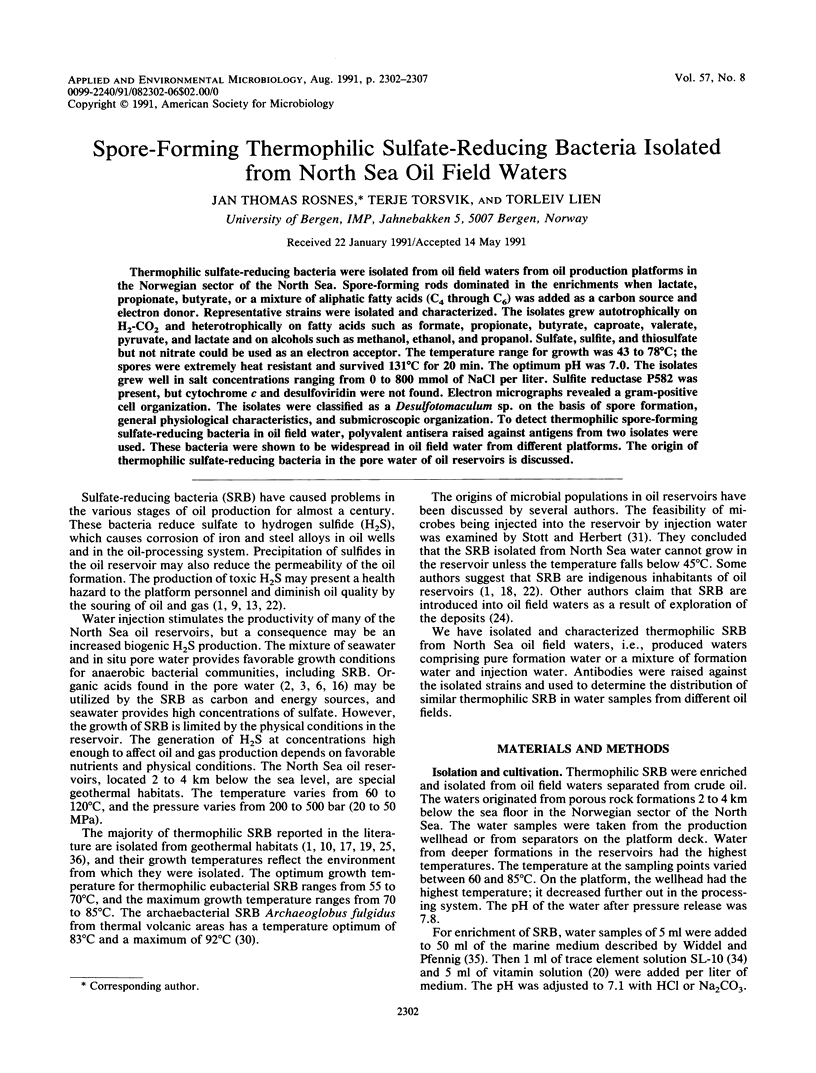
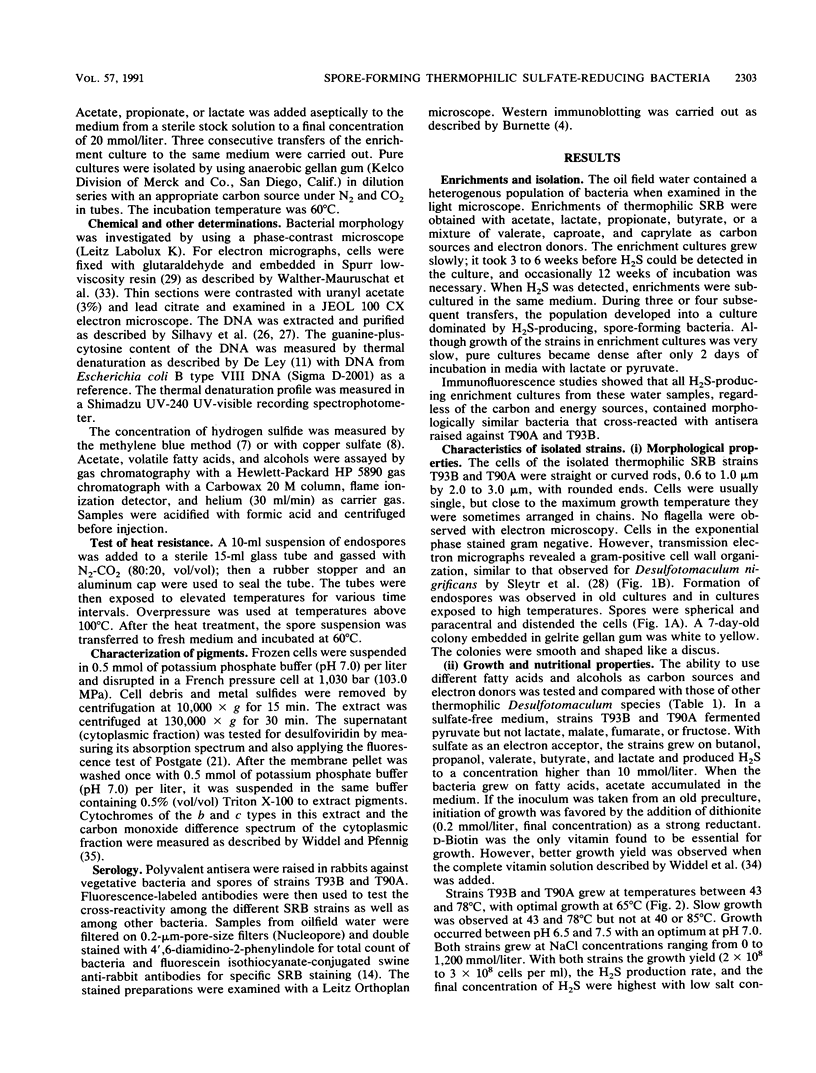
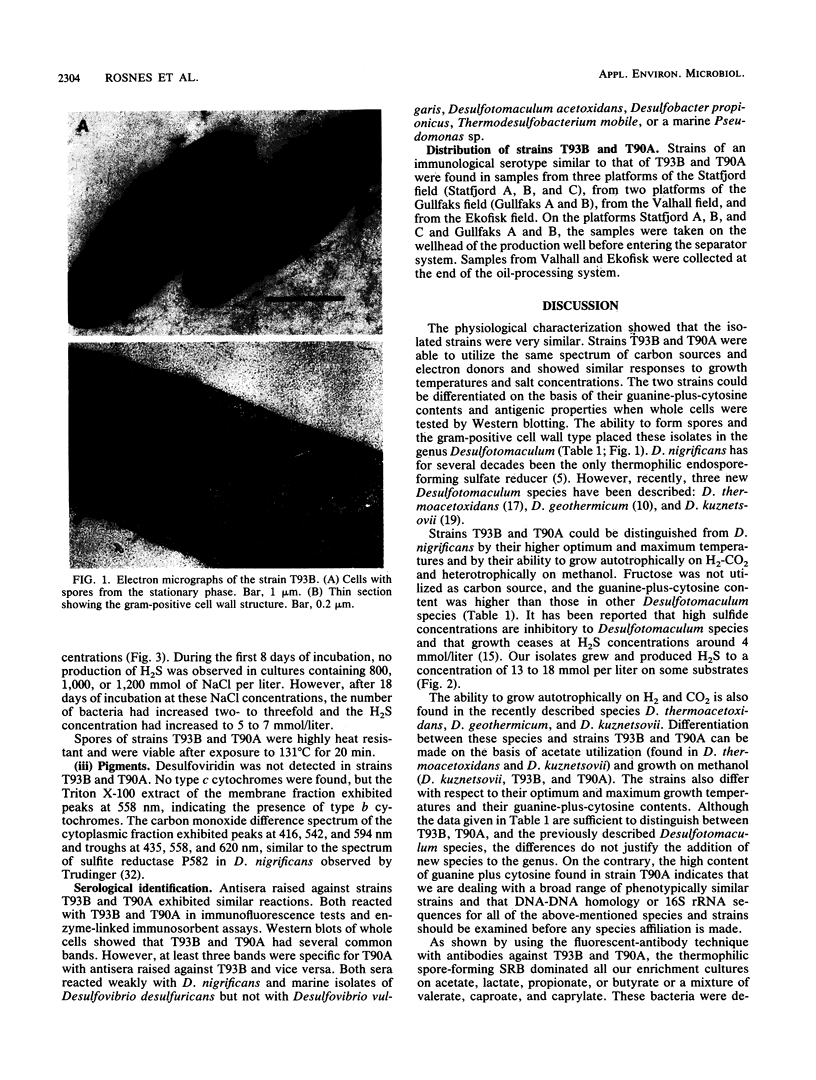
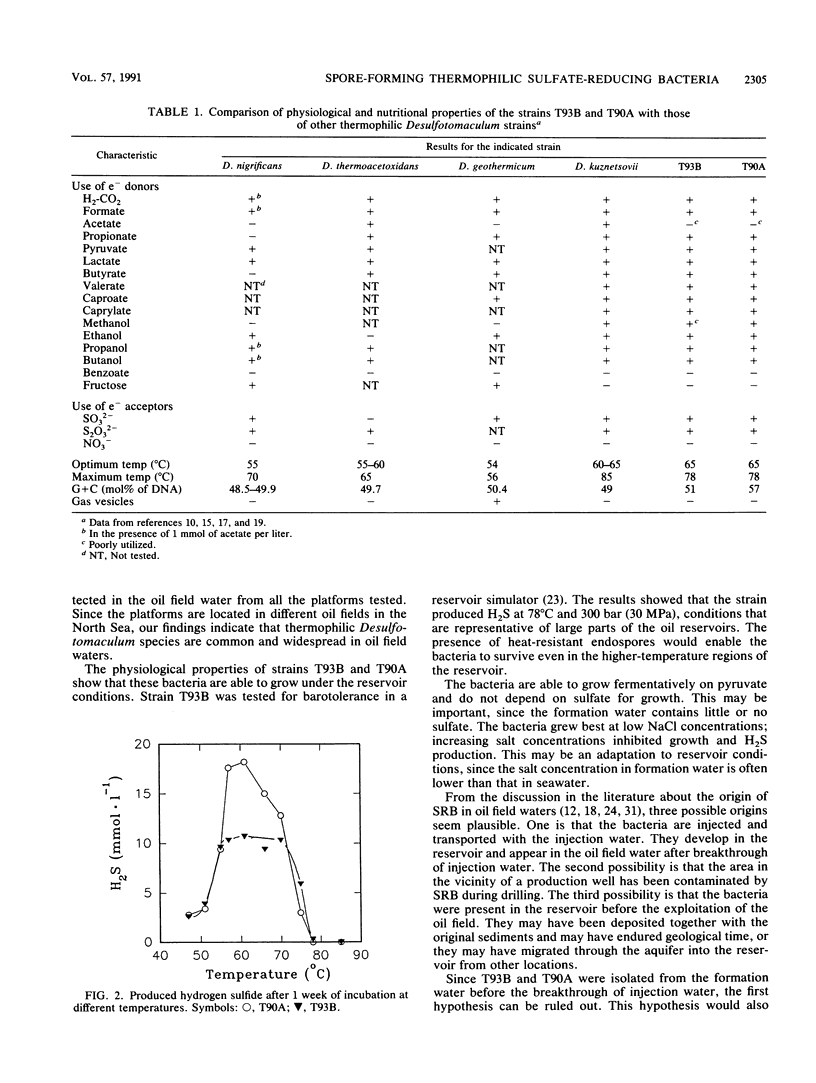
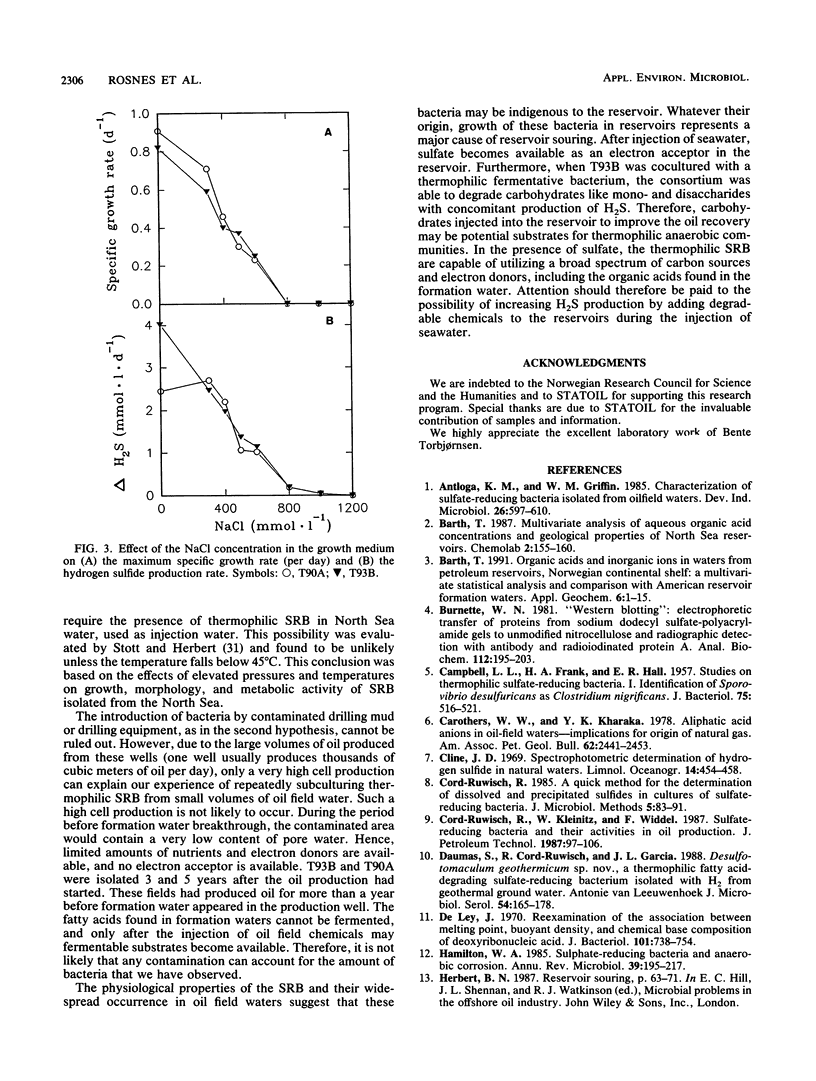
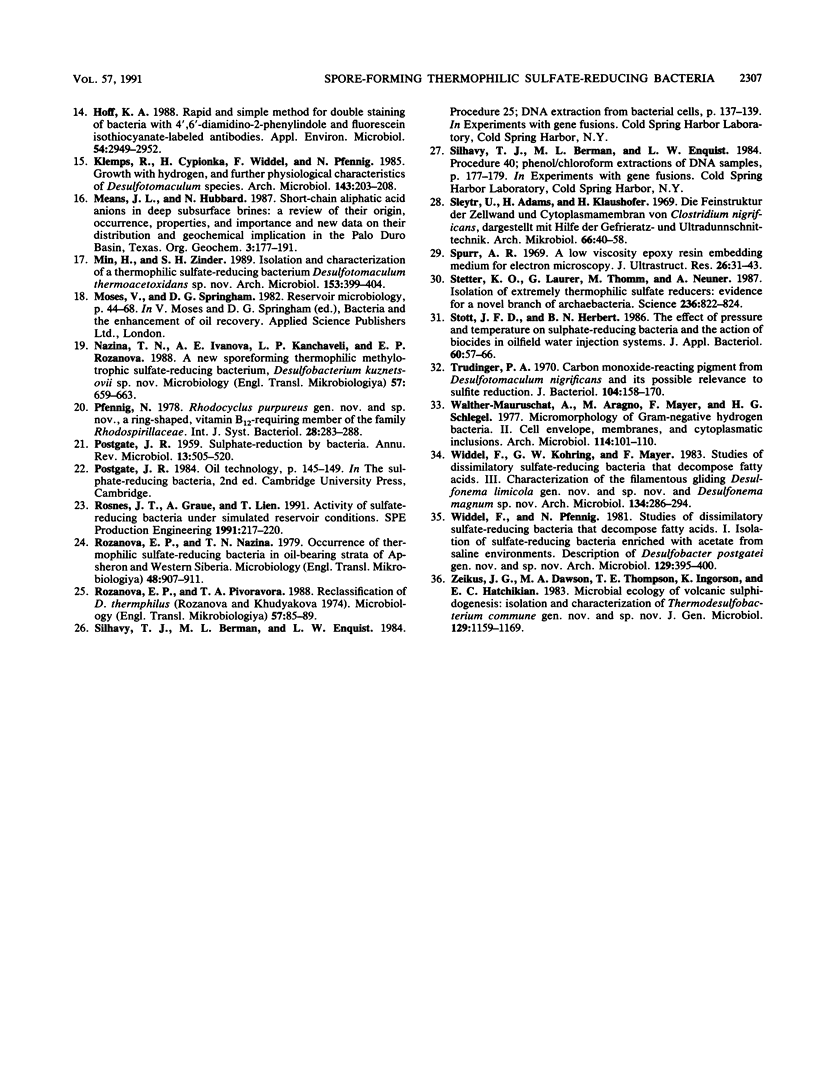
Images in this article
Selected References
These references are in PubMed. This may not be the complete list of references from this article.
- Burnette W. N. "Western blotting": electrophoretic transfer of proteins from sodium dodecyl sulfate--polyacrylamide gels to unmodified nitrocellulose and radiographic detection with antibody and radioiodinated protein A. Anal Biochem. 1981 Apr;112(2):195–203. doi: 10.1016/0003-2697(81)90281-5. [DOI] [PubMed] [Google Scholar]
- CAMPBELL L. L., Jr, FRANK H. A., HALL E. R. Studies on thermophilic sulfate reducing bacteria. I. Identification of Sporovibrio desulfuricans as Clostridium nigrificans. J Bacteriol. 1957 Apr;73(4):516–521. doi: 10.1128/jb.73.4.516-521.1957. [DOI] [PMC free article] [PubMed] [Google Scholar]
- Daumas S., Cord-Ruwisch R., Garcia J. L. Desulfotomaculum geothermicum sp. nov., a thermophilic, fatty acid-degrading, sulfate-reducing bacterium isolated with H2 from geothermal ground water. Antonie Van Leeuwenhoek. 1988;54(2):165–178. doi: 10.1007/BF00419203. [DOI] [PubMed] [Google Scholar]
- De Ley J. Reexamination of the association between melting point, buoyant density, and chemical base composition of deoxyribonucleic acid. J Bacteriol. 1970 Mar;101(3):738–754. doi: 10.1128/jb.101.3.738-754.1970. [DOI] [PMC free article] [PubMed] [Google Scholar]
- Hamilton W. A. Sulphate-reducing bacteria and anaerobic corrosion. Annu Rev Microbiol. 1985;39:195–217. doi: 10.1146/annurev.mi.39.100185.001211. [DOI] [PubMed] [Google Scholar]
- Hoff K. A. Rapid and simple method for double staining of bacteria with 4',6-diamidino-2-phenylindole and fluorescein isothiocyanate-labeled antibodies. Appl Environ Microbiol. 1988 Dec;54(12):2949–2952. doi: 10.1128/aem.54.12.2949-2952.1988. [DOI] [PMC free article] [PubMed] [Google Scholar]
- Sleytr U., Adam H., Klaushofer H. Die Feinstruktur der Zellwand und Cytoplasmamembran von Clostridium nigrificans, dargestellt mit Hilfe der Gefrierätz- und Ultradünnschnittechnik. Arch Mikrobiol. 1969;66(1):40–58. [PubMed] [Google Scholar]
- Spurr A. R. A low-viscosity epoxy resin embedding medium for electron microscopy. J Ultrastruct Res. 1969 Jan;26(1):31–43. doi: 10.1016/s0022-5320(69)90033-1. [DOI] [PubMed] [Google Scholar]
- Stetter K. O., Lauerer G., Thomm M., Neuner A. Isolation of extremely thermophilic sulfate reducers: evidence for a novel branch of archaebacteria. Science. 1987 May 15;236(4803):822–824. doi: 10.1126/science.236.4803.822. [DOI] [PubMed] [Google Scholar]
- Trudinger P. A. Carbon monoxide-reacting pigment from Desulfotomaculum nigrificans and its possible relevance to sulfite reduction. J Bacteriol. 1970 Oct;104(1):158–170. doi: 10.1128/jb.104.1.158-170.1970. [DOI] [PMC free article] [PubMed] [Google Scholar]
- Walther-Mauruschat A., Aragno M., Mayer F., Schlegel H. G. Micromorphology of Gram-negative hydrogen bacteria. II. Cell envelope, membranes, and cytoplasmic inclusions. Arch Microbiol. 1977 Aug 26;114(2):101–110. doi: 10.1007/BF00410770. [DOI] [PubMed] [Google Scholar]
- Widdel F., Pfennig N. Studies on dissimilatory sulfate-reducing bacteria that decompose fatty acids. I. Isolation of new sulfate-reducing bacteria enriched with acetate from saline environments. Description of Desulfobacter postgatei gen. nov., sp. nov. Arch Microbiol. 1981 Jul;129(5):395–400. doi: 10.1007/BF00406470. [DOI] [PubMed] [Google Scholar]



